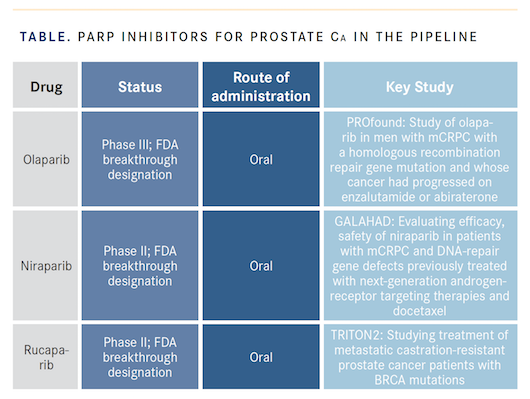Article
PARP inhibitors may mark new era in prostate cancer care
Author(s):
Urologists, oncologists, and prostate cancer patients are entering a new era in prostate cancer therapy-one that is going to be genetically defined.
sebra - stock.adobe.com

Urologists, oncologists, and prostate cancer patients are entering a new era in prostate cancer therapy-one that is going to be genetically defined.

“Treatments are going to be targeting the genetic mutations in prostate cancer,” said Emmanuel S. Antonarakis, MD, professor of oncology and urology at Johns Hopkins Medicine, Baltimore. “And one of the most actionable genetic abnormalities are mutations in the BRCA1 and BRCA2 genes, which collectively account for about 10% of all metastatic prostate cancers.
“The reason why knowing about these BRCA1- or BRCA2-positive patients is paramount is that within about 6 months from now we expect to have at least one FDA-approved PARP inhibitor that can be used in those patients.”
Related: How will PARP inhibitors change advanced PCa treatment?
Among the poly (ADP-ribose) polymerase inhibitors (PARP inhibitors) that are in phase II or III trials for advanced prostate cancer, the furthest along and the only one with phase III data is olaparib (Lynparza). AstraZeneca and Merck announced positive results in early August from the phase III PROfound trial of olaparib in men with metastatic castration-resistant prostate cancer with a homologous recombination repair gene mutation and whose cancer had progressed on hormonal anticancer treatment with enzalutamide (XTANDI) or abiraterone acetate (Zytiga). Olaparib has been granted FDA breakthrough designation for BRCA1- and BRCA2-mutated metastatic castration-resistant prostate cancer.

Among the other PARP inhibitors that researchers have evaluated as prostate cancer monotherapy are niraparib and rucaparib, both of which also have received the FDA breakthrough designation. Janssen presented positive phase II trial results with niraparib at the recent European Society for Medical Oncology annual meeting in Barcelona, Spain. Clinical trials for rucaparib include TRITON2, a phase II study looking at treatment of metastatic castration-resistant prostate cancer patients with BRCA mutations. TRITON2 is enrolling patients with deleterious mutations of other homologous recombination (HR) repair genes, including ATM. The phase III trial, TRITON3, is enrolling patients with BRCA mutations and ATM mutations who have progressed on androgen receptor-targeted therapy and who have not yet received chemo in the castrate-resistant setting.
Still other PARP inhibitors in the prostate cancer treatment pipeline are veliparib (ABT-888) and talazoparib.
The first PARP inhibitor to be approved for prostate cancer will most likely be olaparib, followed by rucaparib, Dr. Antonarakis speculated.
Next: The PARP inhibitor rationale
The PARP inhibitor rationale

The basis for using PARP inhibitors in prostate cancer is based on the high rate of germline and tumor-specific mutations in specific DNA repair enzymes, according to Andrew J. Armstrong, MD, professor of medicine and professor in surgery, Duke Cancer Institute, Durham, NC.
Also see: What has been the most significant advance in prostate cancer in 2019?
“In men with metastatic prostate cancer, about 10% will have germline mutations in DNA repair genes like BRCA2, and another 10% or so will have tumor-specific mutations in these same genes, including more than a dozen of these specific genes. And these genes when mutated often confer sensitivity to the PARP inhibitors. They also confer higher risk of cancers, like prostate cancer, breast, and ovarian cancers in family members when they are in the germline,” said Dr. Armstrong, an investigator in the PROfound trial.
“Overall, about 20% to 22% of men with metastatic prostate cancer are predicted to have these mutations either in their bodies or in their tumors. That’s the basis for using DNA damaging agents, like platinum chemotherapy or PARP inhibition, to take advantage of those vulnerabilities in the cancer cell, and to benefit patients with longer survival and freedom from disease progression and spread.”
The FDA has previously approved PARP inhibitors for treatment of breast and ovarian cancers.
The term describing the rationale for using PARPi medications to treat prostate cancer patients with BRCA1 or BRCA2 mutations is “synthetic lethality,” which means the cancer cell loses its ability to repair two types of DNA damage-both single-strand and double-strand DNA damage, according to Dr. Antonarakis, who has conducted research on using these drugs in prostate cancer and sometimes uses them off label.
“Every time a cancer cell replicates, it accumulates DNA damage, as well as from oxidative stress and ionizing radiation. The way that cancer cells primarily fix double-strand DNA breaks is by using the BRCA1 and BRCA2 proteins by a process called homologous recombination. The main way that they fix single-strand breaks in the DNA is by the PARP enzymes, mainly PARP1, by a process called base-excision repair,” Dr. Antonarakis explained.
Cancers that have mutations in BRCA1 or BRCA2 (or some other homologous recombination genes) are not able to fix double-strand breaks as they accumulate DNA damage, and therefore have to become dependent upon single-strand repair mechanisms to fix those breaks.
Read: What do recent studies tell us about finasteride and PCa?
“In other words, the cancer cell has to fix the DNA breaks one strand at a time using base-excision repair. The way that it does that is by using the PARP1 enzyme,” Dr. Antonarakis said. “If you have a patient with a mutation in BRCA1 or BRCA2, the patient’s ability to fix double-strand breaks is crippled. If you therefore pharmacologically inhibit PARP1 with a drug, you are abolishing that cell’s ability to fix the DNA damage by targeting its rescue mechanism and that cell has no choice but to die because it accumulates catastrophic DNA damage.”
Next: Phase III insightPhase III insight
PROfound is the only randomized phase III study of a PARP inhibitor, in this case olaparib, in prostate cancer reported to date, according to Dr. Armstrong. Investigators compared olaparib against physicians’ choice therapy using either enzalutamide or abiraterone.
Also see: AUA updates policy statement on mpMRI for prostate Ca
“The patients in the PROfound study had all progressed on one of the prior therapies with either enzalutamide or abiraterone, so the physicians’ choice would have been to pick the second drug that they hadn’t had. Most of the patients had already failed docetaxel,” Dr. Armstrong said. “It was a randomized study and the patients eligible for this trial had to have had a tumor tissue test that found a mutation in one of several key genes that would have predicted response to these PARP inhibitors.”
Results from the phase III trial showed a statistically significant and clinically meaningful improvement in the primary endpoint of radiographic progression-free survival with olaparib versus enzalutamide or abiraterone in the men studied, according to AstraZeneca and Merck.
“The data that has been publicly described suggests that patients that have BRCA2 [mutations] particularly seem to have a really strong benefit from olaparib. Patients who have other mutations, particularly ATM mutations, don’t seem to have as strong of a benefit, so it will be interesting to see how regulators look at different biomarkers within the PROfound study based on the type of mutation the patient has,” Dr. Armstrong said. “Not all the mutations are created equally, nor do they respond the same way to these drugs.”
PARP inhibitor differentiators
PARP inhibitors generally are similar in that all are administered orally, but dosages among the different agents vary, according to Dr. Antonarakis.
“They are slightly different in their side effect profiles; however, practicing community oncologists and urologists need to know that these drugs are broadly equivalent in terms of their relative effectiveness and in terms of their safety,” Dr. Antonarakis said. “The data that we have so far does not appear to suggest that one of the PARP inhibitors is more effective than the others, nor does it suggest that one of the PARP inhibitors is more toxic than the others.”
The side effect profiles among PARP inhibitors are similar to a mild chemotherapy, according to Dr. Antonarakis.
Common side effects include decreased energy, fatigue, nausea, low appetite, and sometimes weight loss; decreased white blood cell, red blood cell, and platelet counts; and slightly increased risk of infection if neutropenia occurs. With long-term use, these drugs also have a theoretical risk of triggering myelodysplastic syndrome or acute leukemia, Dr. Antonarakis said.
The major shortcoming of using PARP inhibitors in prostate cancer is that the drugs will only be relevant in about 10% of advanced prostate cancers. Nine in 10 prostate cancer patients do not have BRCA1 or BRCA2 mutations, according to Dr. Antonarakis.
“The second shortcoming is that even in those 10% of patients that have a BRCA1 or BRCA2 mutation, PARP inhibitors will only work in about half of those patients,” he said. “Therefore, these drugs are likely to only be effective in about 5% of the overall prostate cancer population.”
The final limitation, according to Dr. Antonarakis, is that even in those 5% (of the total population) who respond to PARP inhibitor treatment, the average response will last 6 to 12 months. Unfortunately, these drugs are not curative.
“One of the unanswered questions-and there are many that the field is trying to figure out-is why is it that patients who have an initial response to PARP inhibition eventually become resistant to the therapy 6 to 12 months later,” Dr. Antonarakis said.
Also lacking are clear data showing that men live longer because of the PARP inhibitors, according to Dr. Armstrong.
Read: PARP inhibitor significantly extends rPFS vs. hormonal therapy
“That data is still immature,” he said. “The outcomes in the PROfound study were mostly progression-free survival. And we’re still needing longer follow-up to know whether that will translate into longer life expectancy. Certainly, there are more costs associated with these drugs, so you like to see those long-term survival benefits.”
Next: Beyond BRCA1/2Beyond BRCA1/2
PARP inhibitors don’t have sufficient activity in patients without specific DNA repair gene mutations when used as monotherapy. But there are ongoing trials, including the PROpel trial, led by Dr. Armstrong, which is looking at combining drugs that block the androgen receptor, such as abiraterone, with a PARP inhibitor in prostate cancer patients who don’t have BRCA1/2 mutations.
“The rationale here is a little different,” Dr. Armstrong said. “The androgen receptor actually promotes DNA damage repair and when you block the androgen receptor with these drugs, like abiraterone or enzalutamide, you block DNA repair, much like when you have a BRCA2 mutation. This is the basis for the ability of hormonal therapy to radiosensitize prostate cancer and improve survival during radiation treatment. The idea here is, if you combine these drugs you may get an important relationship where the PARP inhibitors now can work more broadly in all patients as long as they are combined with one of these potent androgen receptor inhibitors.
“Initial phase 2 studies of olaparib and abiraterone demonstrated more prolonged progression-free survival over abiraterone, for example. And the combination of PARP inhibition and androgen receptor inhibition is now tested in several phase III studies, and the PROpel study is one that’s ongoing now.”
Future implications
Medical oncologists, as opposed to urologists, will be the primary providers to prescribe PARP inhibitor medications for prostate cancer in practice, Dr. Antonarakis speculates.
“That’s because the FDA label for these drugs is likely to be for patients who already have metastatic castration-resistant prostate cancer and who have previously received at least one novel hormonal therapy like abiraterone or enzalutamide, and perhaps also in patients who have received at least one taxane chemotherapy,” he said. “That remains to be determined, because we don’t know exactly how the FDA will rule on this. But I think it’s important that urologists are aware of these drugs so they can appropriately refer their patients to medical oncology if a BRCA1 or BRCA2 mutation is discovered.”
Also see: Focal therapy vs. surveillance for low-risk PCa
Also, researchers are just beginning to uncover ways in which PARP inhibitors might benefit prostate cancer patients earlier in the disease course. Depending on how those studies pan out, PARP inhibitors could potentially be used in the future in prostate cancer before it becomes castration resistant or metastatic, and urologists would be among the prescribers if that’s the case, according to Dr. Antonarakis.
Such studies are ongoing. In one trial, olaparib is being used for biochemically recurrent non-metastatic prostate cancer (NCT03047135); in another, rucaparib is being used without androgen deprivation in men with metastatic hormone-sensitive prostate cancer with germline BRCA1 or BRCA2 mutations (NCT03413995).
Emerging data on PARP inhibitors highlight the value of genetic testing and counseling in urology and oncology clinics, according to Dr. Armstrong.
“There are incentives now to do both hereditary and tumor-specific genetic testing and counseling to open the door for patients that could have clinical benefits from PARP inhibitors as well as to help in the early detection and treatment of patients with familial cancer syndromes,” he said.
Disclosures: Dr. Armstrong reports consulting and research ties with AstraZeneca, Pfizer/Astellas, Janssen, Merck, Bristol-Myers Squibb, and Bayer. Dr. Antonarakis reports receiving personal fees and funding to his institution from Johnson & Johnson, Janssen, AstraZeneca, Merck, Pfizer, and Clovis.
















